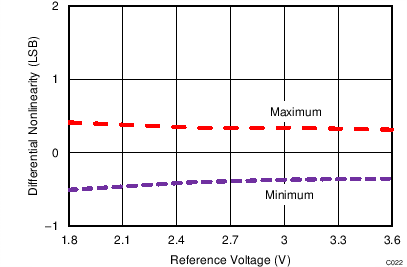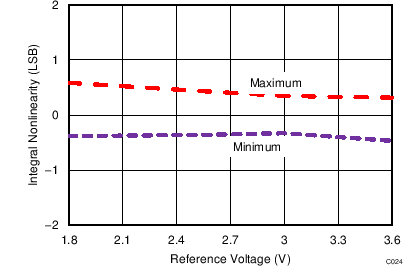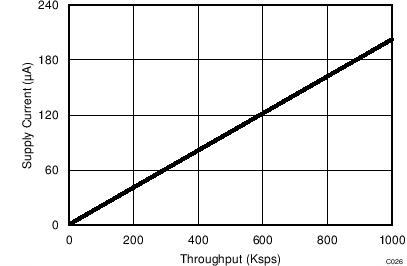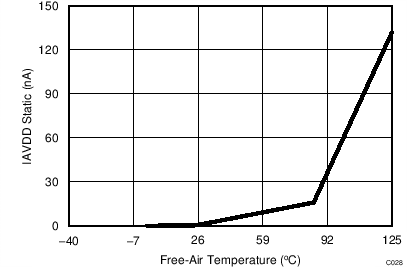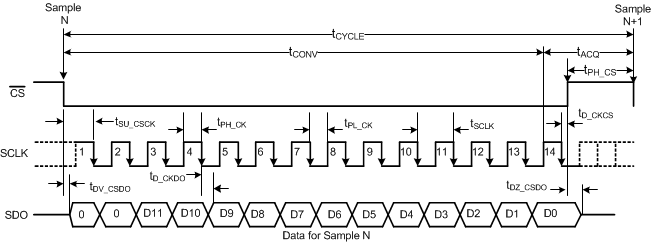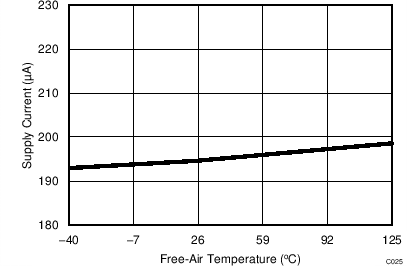SBAS608C June 2014 – December 2015 ADS7042
PRODUCTION DATA.
- 1 Features
- 2 Applications
- 3 Description
- 4 Revision History
- 5 Companion Products
- 6 Device Comparison
- 7 Pin Configuration and Functions
- 8 Specifications
- 9 Parameter Measurement Information
- 10Detailed Description
- 11Application and Implementation
- 12Power-Supply Recommendations
- 13Layout
- 14Device and Documentation Support
- 15Mechanical, Packaging, and Orderable Information
パッケージ・オプション
デバイスごとのパッケージ図は、PDF版データシートをご参照ください。
メカニカル・データ(パッケージ|ピン)
- DCU|8
- RUG|8
サーマルパッド・メカニカル・データ
発注情報
8 Specifications
8.1 Absolute Maximum Ratings(1)
| MIN | MAX | UNIT | |
|---|---|---|---|
| AVDD to GND | –0.3 | 3.9 | V |
| DVDD to GND | –0.3 | 3.9 | V |
| AINP to GND | –0.3 | AVDD + 0.3 | V |
| AINM to GND | –0.3 | 0.3 | V |
| Digital input voltage to GND | –0.3 | DVDD + 0.3 | V |
| Storage temperature, Tstg | –60 | 150 | °C |
(1) Stresses beyond those listed under Absolute Maximum Ratings may cause permanent damage to the device. These are stress ratings only, which do not imply functional operation of the device at these or any other conditions beyond those indicated under Recommended Operating Conditions. Exposure to absolute-maximum-rated conditions for extended periods may affect device reliability.
8.2 ESD Ratings
| VALUE | UNIT | |||
|---|---|---|---|---|
| V(ESD) | Electrostatic discharge | Human body model (HBM), per ANSI/ESDA/JEDEC JS-001(1) | ±2000 | V |
| Charged device model (CDM), per JEDEC specification JESD22-C101(2) | ±1000 | |||
(1) JEDEC document JEP155 states that 500-V HBM allows safe manufacturing with a standard ESD control process.
(2) JEDEC document JEP157 states that 250-V CDM allows safe manufacturing with a standard ESD control process.
8.3 Recommended Operating Conditions
over operating free-air temperature range (unless otherwise noted)| MIN | MAX | UNIT | ||
|---|---|---|---|---|
| AVDD | Analog supply voltage range | 1.65 | 3.6 | V |
| DVDD | Digital supply voltage range | 1.65 | 3.6 | V |
| TA | Operating free-air temperature | –40 | 125 | °C |
8.4 Thermal Information
| THERMAL METRIC(1) | ADS7042 | UNIT | ||
|---|---|---|---|---|
| RUG (X2QFN) | DCU (VSSOP) | |||
| 8 PINS | 8 PINS | |||
| RθJA | Junction-to-ambient thermal resistance | 177.5 | 235.8 | °C/W |
| RθJC(top) | Junction-to-case (top) thermal resistance | 51.5 | 79.8 | °C/W |
| RθJB | Junction-to-board thermal resistance | 76.7 | 117.6 | °C/W |
| ψJT | Junction-to-top characterization parameter | 1.0 | 8.9 | °C/W |
| ψJB | Junction-to-board characterization parameter | 76.7 | 116.5 | °C/W |
| RθJC(bot) | Junction-to-case (bottom) thermal resistance | N/A | N/A | °C/W |
(1) For more information about traditional and new thermal metrics, see the IC Package Thermal Metrics application report, SPRA953.
8.5 Electrical Characteristics
At TA = –40°C to 125°C, AVDD = 3 V, DVDD = 1.65 V to 3.6 V, fSAMPLE = 1 MSPS, and VAINM = 0 V, unless otherwise noted.| PARAMETER | TEST CONDITIONS | MIN | TYP | MAX | UNIT | ||
|---|---|---|---|---|---|---|---|
| ANALOG INPUT | |||||||
| Full-scale input voltage span(1) | 0 | AVDD | V | ||||
| Absolute input voltage range | AINP to GND | –0.1 | AVDD + 0.1 | V | |||
| AINM to GND | –0.1 | 0.1 | |||||
| CS | Sampling capacitance | 15 | pF | ||||
| SYSTEM PERFORMANCE | |||||||
| Resolution | 12 | Bits | |||||
| NMC | No missing codes | 12 | Bits | ||||
| INL | Integral nonlinearity | AVDD = 3 V | –1 | ±0.7 | 1 | LSB(2) | |
| AVDD = 1.8 V | –2 | ±1 | 2 | ||||
| DNL | Differential nonlinearity | AVDD = 3 V | –0.99 | ±0.5 | 1 | LSB | |
| AVDD = 1.8 V | –0.99 | ±0.7 | 2 | ||||
| EO | Offset error | Uncalibrated | AVDD = 1.65 V to 3.6 V | ±12 | LSB | ||
| Calibrated(6) | AVDD = 3 V | –3 | ±0.5 | 3 | |||
| AVDD = 1.8 V | –4 | ±1 | 4 | ||||
| dVOS/dT | Offset error drift with temperature | 5 | ppm/°C | ||||
| EG | Gain error | AVDD = 3 V | –0.1 | ±0.05 | 0.1 | %FS | |
| AVDD = 1.8 V | –0.2 | ±0.1 | 0.2 | ||||
| Gain error drift with temperature | 2 | ppm/°C | |||||
| SAMPLING DYNAMICS | |||||||
| tACQ | Acquisition time | 200 | ns | ||||
| Maximum throughput rate | 16-MHz SCLK, AVDD = 1.65 V to 3.6 V | 1 | MHz | ||||
| DYNAMIC CHARACTERISTICS | |||||||
| SNR | Signal-to-noise ratio(4) | fIN = 2 kHz, AVDD = 3 V | 69 | 70 | dB | ||
| fIN = 2 kHz, AVDD = 1.8 V | 68 | ||||||
| THD | Total harmonic distortion(4)(3) | fIN = 2 kHz, AVDD = 3 V | –80 | dB | |||
| SINAD | Signal-to-noise and distortion(4) | fIN = 2 kHz, AVDD = 3 V | 68 | 69.5 | dB | ||
| fIN = 2 kHz, AVDD = 1.8 V | 67.5 | ||||||
| SFDR | Spurious-free dynamic range(4) | fIN = 2 kHz, AVDD = 3 V | 80 | dB | |||
| BW(fp) | Full-power bandwidth | At –3 dB, AVDD = 3 V | 25 | MHz | |||
| DIGITAL INPUT/OUTPUT (CMOS Logic Family) | |||||||
| VIH | High-level input voltage(5) | 0.65 DVDD | DVDD + 0.3 | V | |||
| VIL | Low-level input voltage(5) | –0.3 | 0.35 DVDD | V | |||
| VOH | High-level output voltage(5) | At Isource = 500 µA | 0.8 DVDD | DVDD | V | ||
| At Isource = 2 mA | DVDD – 0.45 | DVDD | |||||
| VOL | Low-level output voltage(5) | At Isink = 500 µA | 0 | 0.2 DVDD | V | ||
| At Isink = 2 mA | 0 | 0.45 | |||||
| POWER-SUPPLY REQUIREMENTS | |||||||
| AVDD | Analog supply voltage | 1.65 | 3 | 3.6 | V | ||
| DVDD | Digital I/O supply voltage | 1.65 | 3 | 3.6 | V | ||
| IAVDD | Analog supply current | At 1 MSPS with AVDD = 3 V | 230 | µA | |||
| At 100 kSPS with AVDD = 3 V | 23 | ||||||
| At 1 MSPS with AVDD = 1.8 V | 130 | ||||||
| PD | Power dissipation | At 1 MSPS with AVDD = 3 V | 690 | µW | |||
| At 100 kSPS with AVDD = 3 V | 69 | ||||||
| At 1 MSPS with AVDD = 1.8 V | 234 | ||||||
(1) Ideal input span; does not include gain or offset error.
(2) LSB means least significant bit.
(3) Calculated on the first nine harmonics of the input frequency.
(4) All specifications expressed in decibels (dB) refer to the full-scale input (FSR) and are tested with an input signal 0.5 dB below full-scale, unless otherwise specified..
(5) Digital voltage levels comply with the JESD8-7A standard for DVDD from 1.65 V to 1.95 V. See the Digital Voltage Levels section for more details.
(6) Refer to the Offset Calibration section for more details.
8.6 Timing Characteristics
All specifications are at TA = –40°C to 125°C, AVDD = 1.65 V to 3.6 V, DVDD = 1.65 V to 3.6 V, and CLOAD on SDO = 20 pF, unless otherwise specified.8.7 Typical Characteristics
At TA = 25°C, AVDD = 3 V, DVDD = 1.8 V, and fSAMPLE = 1 MSPS, unless otherwise noted.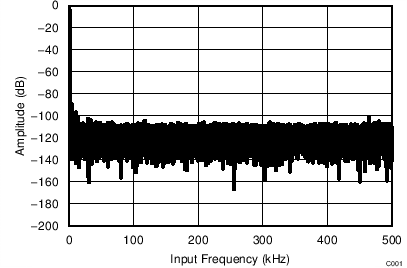
| SNR = 70.62 dB | THD = –83.96 dB | fIN = 2 kHz |
| Number of samples = 32768 | ||
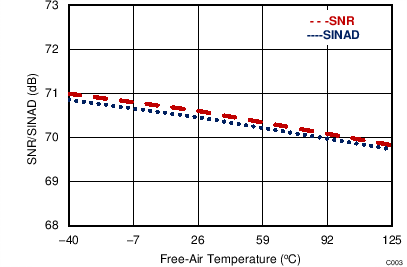
| fIN = 2 kHz |
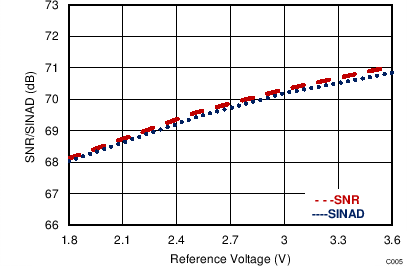
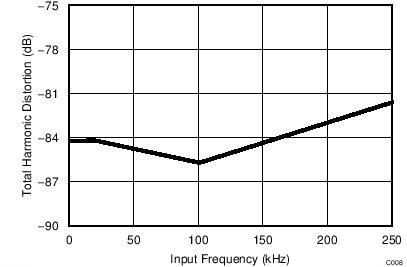
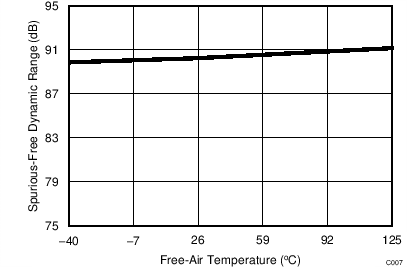
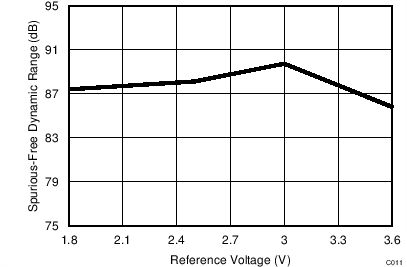
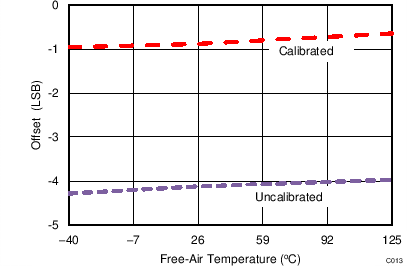
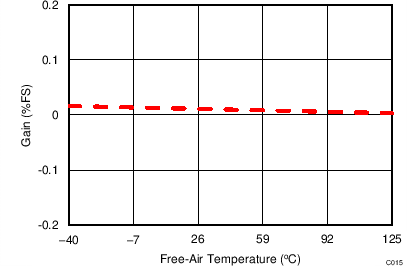
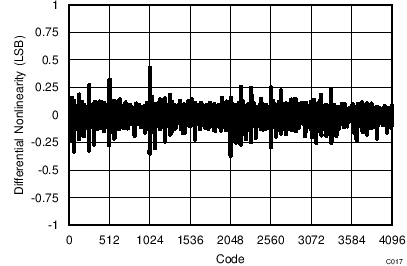
| AVDD = 3 V |
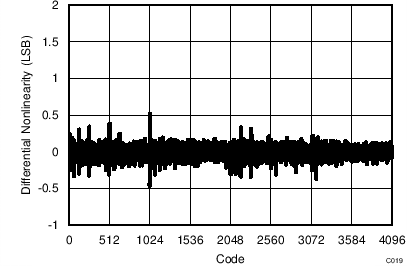
| AVDD = 1.8 V |
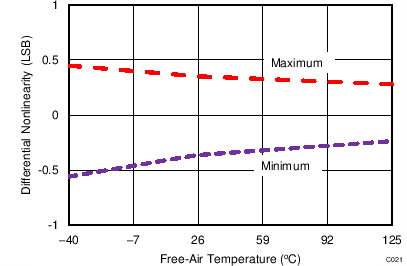
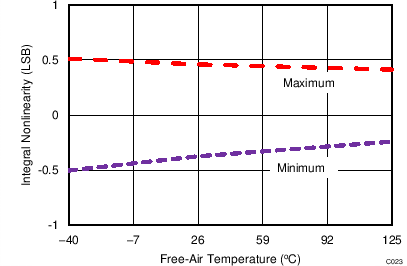
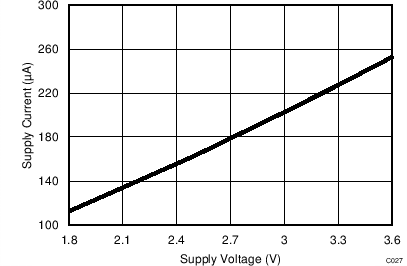
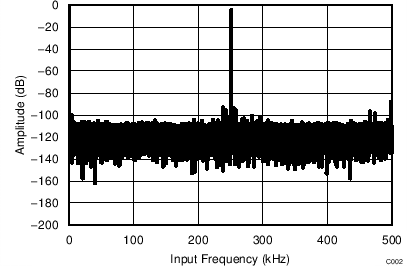
| SNR = 70.22 dB | THD = –81.58 dB | fIN = 250 kHz |
| Number of samples = 32768 | ||
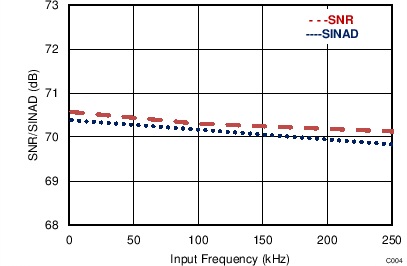
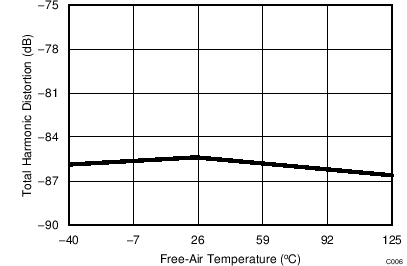
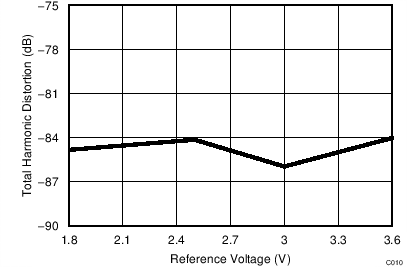
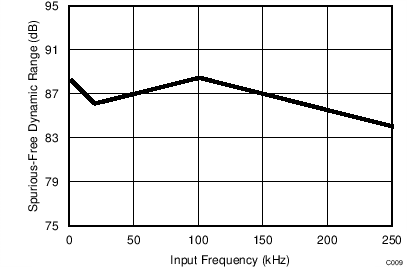
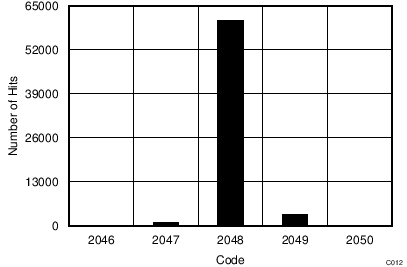
| Mean code = 2048.04 | Sigma = 0.27 | |

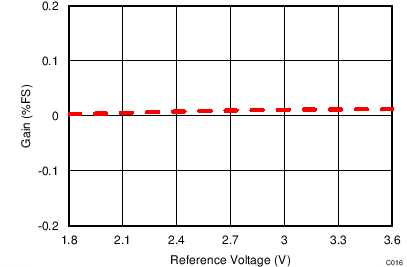
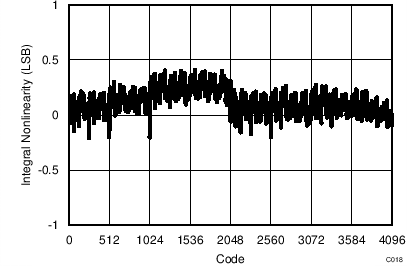
| AVDD = 3 V |
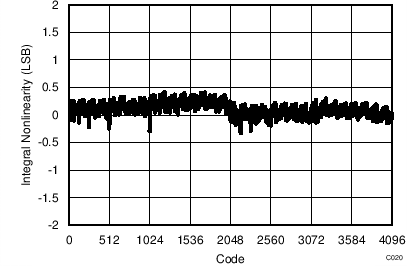
| AVDD = 1.8 V |
